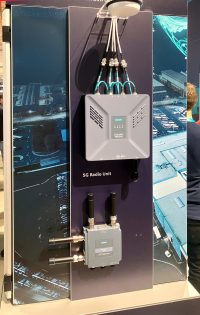Sponsors Article
Siemens offers complete 5G Campusnet solution and test lab
Siemens now offers all the elements for a 5G campus network from a single source. (Source: Siemens)
Three years ago, Siemens came onto the market with a 5G router – and promised more for 2023. Now the company is preparing to keep its promise. It’s not just about technology – it’s also about a paradigm shift for the automation manufacturer.
At the Hanover Fair, Siemens presented its solution for industrial 5G campus networks for the first time. The Scalance MUM856-1 has been in the range since 2020 and, thanks to its IP65 housing, can be mounted outdoors or directly on machines or mobile units. In addition, there is the Scalance MUM853-1, which is intended as a more compact variant for use in control cabinets.
Complete Campusnet solution from a single source
This year, all the other components needed to build a 5G private network based entirely on Siemens technology will be added. The components of the Radio Access Network (RAN) include the user equipment (UE) – i.e. the routers mentioned above – the radio base stations (Next Generation NodeB, gNB) with their antennas, as well as the control and data processing technology, which in 5G includes central unit (CU), control, authentication and mobility management, as well as a distributed unit (DU) with data processing and transmission functions. These are hosted on Siemens’ own industrial PCs (IPC).
In general, the strategy was to take up building blocks of the telecommunications market and adapt them for use in the context of Industry 4.0. First and foremost is a separate 5G core to operate the Campusnet. The German industrial group draws on existing technology and has further developed it to meet the requirements of industrial and small to medium-sized enterprises. In a first phase, the RAN units also come from an unnamed ODM manufacturer. In the coming year, the company will then offer all the hardware in-house, says Daniel Mai, who recently took over responsibility for Sander Rotmensen’s division.
Paradigm shift
For Siemens, providing a complete connectivity solution for a private industrial 5G enterprise network also means changing its positioning. While the company had previously been perceived as an “automation company” that supports use cases and applications in the Industry 4.0 environment with its products, the company is now moving more into the role of an infrastructure provider and is increasingly confronted with strategic questions and overarching integration requirements, Mai explained in an interview with FUENF-G.de. Siemens have to adapt to this, for example, in sales and offer more consulting.
While the presentation of the 5G Campus solution at the Hanover Fair in April was more of a “silent” launch, the opening of the Industrial Connectivity Lab in Erlangen was duly celebrated. Embedded in the Siemens Technology Center on the Erlangen campus, the 300-square-meter test laboratory enables extensive practical tests of various connection solutions. For example, Siemens has obtained its own 5G license in the industrial spectrum at 3.7 GHz from the German Federal Network Agency, which will also allow customers on the site to gain their own experience with the new mobile communications standard. In addition, industrial WLAN, real-time localization systems (RTLS) and radio frequency identification (RFID) are also available. In this way, different scenarios can be simulated, also in combination with the technologies. In addition, remote applications are also part of the test portfolio via ADSL connections.
“Many users find it difficult to assess the benefits and framework conditions of wireless technologies in their own operations. The Industrial Connectivity Lab offers our customers the great advantage of being able to combine different connectivity technologies and test them with us under industrial conditions.”
Axel Lorenz, CEO Process Automation at Siemens
Practical tests are underway
Lorenz sees an enormous need for tailor-made communication solutions, which arises from the increasing convergence of OT and IT in industrial plants. 5G is the latest component with which Siemens is now starting in its home country, as well as in Brazil, which provides spectrum for industry in the same frequency range (3.7-3.8 GHz). Other markets are to follow, insofar as they offer opportunities in this or adjacent bands. Other frequency ranges would only be covered later.
Siemens is testing how the technology can be used in manufacturing both in cooperation with a number of customers and in-house. The Siemens manufacturing facility in Karlsruhe (MF-K) is equipped with its own 5G campus solution to enable agile workflows and flexible production adjustments. Mobile applications in particular benefit from the 5G connection, namely intralogistics with its automated guided vehicles (AGVs) and autonomous mobile robots (AMRs), which deliver components and semi-finished products in flowing matrix production to the next module, where they are to be further processed.
Another test, in cooperation with modem chip manufacturer Qualcomm, deals with the use of 5G for smart building technology. This runs at the Siemens site in Chicago, where a private 5G home network in the CBRS spectrum takes over, among other things, networking and managing heating, ventilation and air conditioning (HVAC) systems. The use cases studied include improved energy efficiency as well as reduced costs, increased security and proactive maintenance in smart buildings.
Further building blocks in the environment
Siemens has had 5G routers in its range for several years. One year ago, Siemens added Profinet over 5G functionality using Virtual Extensible LAN (VXLAN) in combination with industrial security appliances from the Scalance S series. VXLAN bridges Layer 2-based Profinet communication with Layer 3 communication for wireless transmission, enabling robust and reliable machine-to-machine communication in real time.
Another building block for the growing IT-OT convergence is Field Data Enablement (FDE). This solution, which can be implemented via both hardware and software, is in turn based on Profinet and provides IT with access to field data from devices that do not have a permanent bus connection with the automation or control system or are only connected to the decentralized I/O system via IO-Link.
Siemens’ policy of a steady hand
The German industrial group still sees itself on a good course. The market for 5G campus networks is just getting started. So far, most projects have been proof-of-concepts. It is true that further development at Siemens will be pushed forward as planned, for example the changeover to Release 16. But they will not get involved in exaggerated promises or tight schedules – especially because they do not have all developments in their own hands.
The switch to 5G Release 16 is the best example of this. Solutions offered so far, including those of Siemens, are based on Release 15 of the 3GPP standard. We have compiled for you here what improvements and innovations the industry can expect from the next 5G version.
For Siemens, a solution is “R16” if it meets all the requirements of the standard that are relevant to the industry. However, the implementation is the responsibility of the chip manufacturers – and in some cases they already see themselves on an R16 course even if only part of the standard has been implemented. As in the past, Siemens intends to act with restraint in the interests of its customers. The company expects at least three years between the adoption of a standard and its implementation “in silicon”, i.e. the corresponding chips.
In fact, many chipmakers have announced that they will provide R16-compatible chips in late 2023 or early 2024 – but not to meet all specifications initially.






